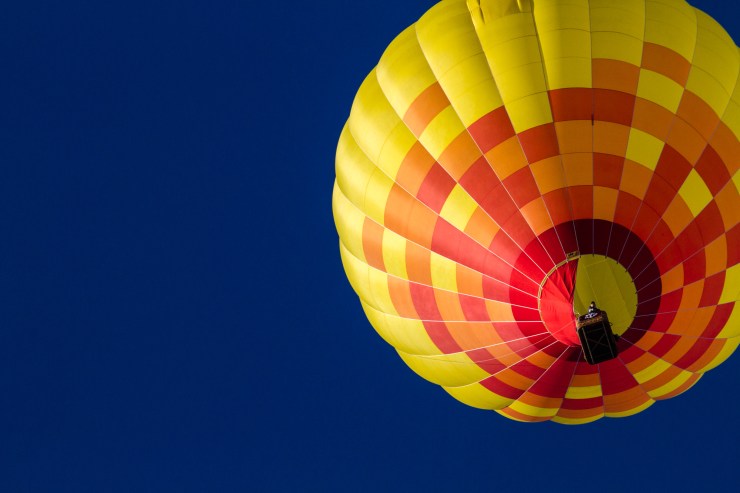When it comes to photographic composition, one of the most well-known “rules” is known as the “rule of thirds.” Many photographers dismiss the rule of thirds as being overly simplistic and not always applicable in the real world of photography. However, if we consider the underlying principles behind the rule of thirds, I think you will find it is a good concept to keep in mind when framing up a scene with your camera.
The basic concept
The underlying principle of the rule of thirds involves dividing the scene you are photographing into equal thirds, both horizontally and vertically. The key subject you are photographing should then be placed along one of the virtual lines that divide the frame into thirds.

So, if you are photographing a hot-air balloon set against a clear blue sky, you might frame the scene so that the balloon appears one third of the way from the left edge of the frame. In other words, the balloon will be positioned along one of the lines that divides the image into thirds, in this case horizontally.

Taking this concept a step further, you might position the key subject at the intersection of a horizontal and a vertical line dividing the image into thirds. In other words, the subject would be positioned near one of the corners of the image.

The real point of the rule of thirds
From my perspective, the real point of the rule of thirds doesn’t really have anything to do with dividing the frame into three sections horizontally and vertically. After all, there isn’t anything especially magical about a line positioned one-third of the way from the edge of the frame.
One of the most important aspects of the rule of thirds isn’t about the “thirds,” but rather about the notion of not placing the key subject right at the center of the frame. In other words, having the key subject off-center in the frame can provide a better sense of balance for a composition.
Taking the concept behind the rule of thirds a bit further, it is worth keeping in mind that you don’t need to be precise about always placing your key subject along one of the virtual lines that divide an image into thirds. In many cases you can put that key subject even further away from the center of the frame with excellent results. The key is to generally avoid having the prominent subject (or even the horizon line) at the exact center of the frame.

Which third?
A corollary to the rule of thirds relates to providing space for a subject to look or move toward. For example, if a subject is looking toward the left, it is best to have more open space on the left side of the image than on the right side. Otherwise there may be a feeling of tension because the subject seems to be looking out of the frame.
Similarly, with a moving subject you will generally want to have more space ahead of that direction of movement. So if a bird in flight is traveling from left to right, you would want more space on the right side of the frame than on the left, so the subject has space to move.
In some cases you may not have a subject looking or moving in a particular direction, but you still want to follow the rule of thirds. In that case you will want to consider which portion of the scene is more interesting or unique. Often you can make a decision based on what inspired you to photograph the scene in the first place. If the sky is what caught your eye, for example, you will probably want to include more sky than foreground when composing your photo.
So, when framing up a scene while keeping the rule of thirds in mind, it is important to remember that it often isn’t enough to simply place a key subject in a “thirds” position, but to choose the right position based on the direction the subject is looking or moving.

The rule of thirds: not really a rule!
I actually don’t like that the rule of thirds is known as a “rule” unless I also keep in mind the old saying that “rules are made to be broken.”
First, I think it is important to keep in mind that in some cases it can absolutely work great to have the key subject or horizon line centered in the frame. While it is generally best to avoid this approach, for some situations the best composition calls for ignoring the rule of thirds and positioning the subject at the center of the frame.

In addition, sometimes having the subject looking or moving out of the frame works well. It might simply provide the best overall framing of the scene, or provide tension that adds to the mood for a photo. Having a subject looking out of frame can also create a sense of curiosity in the viewer, as they wonder what it is that the subject is looking at.

The reason the rule of thirds is one of the most well-known rules of composition in photography is that in most cases it represents good advice. However, it is important to keep in mind that sometimes it might make perfect sense to break the rule of thirds, or at least to bend the rule a little bit so you aren’t focusing on always placing a subject along a virtual line defining one-third segments for every photo you compose.
Tell your story with the second annual Visual Storytelling Conference!
Experience four days of interactive, online training sessions featuring a range of educational content with experienced photographers and content creators. This free event kicks off with a series of technical boot camps to build essential skills, followed by live, online sessions on photography, video, business and social media. Join live from March 10-13, 2022!
